Society is aging:
- The process was first reported in France in the 1830s, as the result of declining birth rates
- In the 20th century the effect was augmented by gains in life expectancy in the industrialized nations.
There are more older people, with, at the end of the last (20th) century:
- An overall world-wide population growth rate of only 1.6% per year due to a reduction in fecundity and fertility
- An increase in the numbers of older people of 2.8% per year world-wide.
In the Americas, the growth rate of the 60+ age group is expected to be 3.5 times that of the total population by 2010.
The consequence is an ageing society, with a proportionately high
(and increasing) number of older people.
Projected percentage
increase in populations aged 65 and over, 1994-2020
(Butler,
RN. Population aging and health. Brit Med J 1997; 315: 1082-1084)
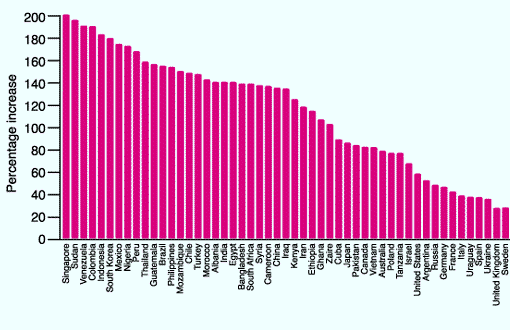
This combination of a shift from high to low mortality and high
to low fertility, which results in population aging, is called the
"demographic transition". But society is aging at a different rate
in different countries.
Many people in developing countries still
live in poverty but are less likely to die than in the past, because
of medical intervention. Fertility rates have also been reduced by
worldwide adoption of modern contraception. So the demographic
transition to an older population is a worldwide phenomenon.
The demographic transition to an older population is a
worldwide phenomenon
Demographic transition in developing and developed
countries
| FEATURE | DEVELOPED COUNTRIES | DEVELOPING COUNTRIES |
| Speed of development | Slow, over a century | Fast, over decades |
| Timing | Already occurred | Occurring |
| Main cause | Consequences of the Industrial revolution | Medical intervention |
The greatest differences are between the developed and developing countries. A simple index which illustrates the differences between countries is:
the number of people aged 60 / the number of people aged under 15
In 1997, this index was 82 in Canada and 9 in Nicaragua,
illustrating the discrepancies between nations. However, the shift
to an older society in the developing nations is expected to catch
up with that of the developed countries.
Population
pyramids in different parts of the world. By the year 2030, most countries
are expected to have a similar age structure.
Population
pyramid - Asia (1995 and 2025)
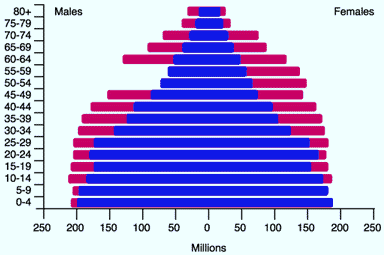
Population pyramid - Latin America (1995 and 2025)

Population pyramid - Europe (1995 and 2025)
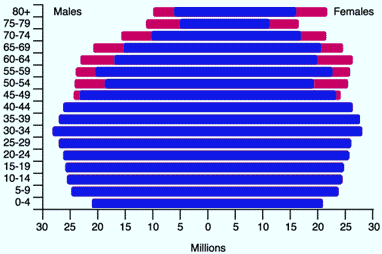
Not only are there more old people but there has been an increase in the old-old. In the last century:
- Average life expectancy from birth increased by more than 25 years
- Five of those years have been added to average life expectancy from base age 65.
Not only are there more old people, but there is an increase in the old-old.
Percentage of population aged 80 and over, 1994 and 2020
(Butler, RN. Population aging and health. Brit Med J 1997; 315: 1082-1084)

The increases in life expectancy vary geographically.
Life expectancy in different countries. In most parts of the
world, women tend to live longer than men do. However, in the
western world the gender gap is narrowing.
(Marsden,K. The
Five percent Solution. Centre for Policy Studies, London, 2000)
| COUNTRY | LIFE EXPECTANCY (years) | ||
| At birth | At 60 years (men) | At 60 years (women) | |
| Japan | 80 | - | - |
| Canada | 79 | - | - |
| France | 78 | 19.9 | 25.1 |
| Italy | 78 | 19.5 | 24.0 |
| Germany | 77 | 18.8 | 23.1 |
| United Kingdom | 77 | 18.8 | 22.5 |
| USA | 76 | 18.8 | 22.5 |
| Lower and middle income countries | 65 | - | - |
| World | 67 | - | - |
Although people in developing countries do not live as long, there are many more old people in them:
- In 1980 they accounted for over half of all people aged 60+ worldwide
- By the end of the 20th century, the figure was 60%
- This is expected to rise to 80% towards the middle of this century.
By 2025, China may have 285 million people aged over 60 years - more than the total present population of the US.
Although people in developing countries do not live as long, there are many more of them
![]()
![]() Health and
the aging of society
Health and
the aging of society
Aging is accompanied by physiological changes and illnesses:
- Aging-dependent changes (normal aging) (see the dedicated section on Physiology: Age-related physiological change)
- Aging-associated changes (pathological aging).
Special medical features of illness in old age
FEATURES OF THE ILLNESS
Insidious onset (a slow reduction of function may be wrongly accepted as an inevitable part of aging)
Multiple pathology. Failure in one system may lead to failure in another Ð a cascade effect. No one disease dominates the clinical picture
Multiple organ failure
Multiple causes of the same symptom. Symptoms which are common to a number of diseases of old age are confusion, falls, incontinence, immobility. These have been called the Geriatric Giants
Chronic incurable diseases more common than in younger people (leading to the epidemiological transition, see below)
FEATURES OF PRESENTATION AND DIAGNOSIS
Late presentation (the Iceberg phenomenon, see below)
Presentation with a social problem which may obscure an underlying disease or complicate its management
Intellectual failure and inability to communicate may complicate history-taking, diagnosis and management
Different presentation to the young. For example:
Multiple factors combine to produce atypical presentation
Old people seem less sensitive to visceral than articular pain
Reduced response of the reticulo-endothelial system, so that leukocytosis and lymphadenopathy are less evident in infections
FEATURES OF MANAGEMENT
Multiple drug use which may complicate management
Some drugs cause as well as cure health problems and this may be critical in older people
The geriatric giants

Epidemiological transition
Younger people are most
likely to die from infections and acute conditions and older people
are most likely to die from chronic and degenerative illnesses and
their complications. Therefore the aging of society means that in
the population as a whole there is a relative increase in the
importance of chronic and degenerative illnesses and their
complications as a cause of death. This increase is called the
epidemiological transition.
There is a change from infections
and acute conditions to chronic and degenerative illness as the
leading causes of death as a population ages
The iceberg phenomenon
Older people use healthcare
services more than younger people. But most are moderate users and
only a few are frequent consulters. Hospital care accounts for most
of the healthcare expenditure in the old as in the young. This is
even though many medical conditions common in older age are chronic
rather than acute emergency problems.
Older people tend to
under-report medical and social problems (the iceberg phenomenon),
for many reasons, including:
- Fear of hospitalization
- Fear of unpleasant investigations
- Fear of treatment
- Risk of involuntary removal to residential care
- Lack of information
- Imagining that symptoms are not amenable to treatment
- Low health expectations
- Failure to recognize the problem.
Older people tend to under-report medical and social problems (the iceberg phenomenon)
![]()
![]() Delaying
illness, prolonging life
Delaying
illness, prolonging life
The changes and conditions that accompany old age are seldom
apparent before middle age, but then their incidence doubles
exponentially every 5 years or so.
It follows that if the onset
or progression of these conditions were delayed by five years, there
would be one less exponential doubling in life. This would have the
effect of halving the incidence of these conditions in older people.
The end result should be:
- Delay in death from these conditions or their complications (which should result in longer life spans)
- A delay/reduction in the development of multiple morbidity states (which increase frailty and dependency)
- Healthier aging.
Age-related conditions may be delayed by the same factors that increase lifespan:
- A better diet and lifestyle (which can be related, among other health advantages, to a lower rate of infectious diseases)
- Modern sanitation, less overcrowding, and improved living conditions generally
- Medical advances, from immunizations and antibiotics to the latest developments
- Provision of, and access to, good healthcare
- Socioeconomic advances (e.g. the availability of pension funds and other provisions for older people).
Age-related conditions may be delayed by the same factors that increase lifespan
Geographical variations in these factors mean that death rates
from specific causes vary with country.
Chances per 1000 at
age 65 of eventually dying from a specified cause. The differences
in risk seen in this table are caused by differences in the factors
that can prolong health and lifespan, e.g. diet, access to good
healthcare.
(Marsden, K. The Five percent Solution. Centre
for Policy Studies, London, 2000)
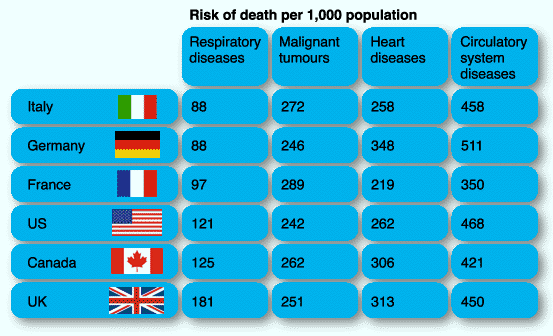
The reduction in mortality from chronic diseases means that older people then become more likely to die from some other cause. It may also mean that there is increased morbidity and disability because of these conditions, if their incidence does not decrease.
![]()
![]() Life
prolonged, disability increased?
Life
prolonged, disability increased?
How big is the increase in years of active life of a good
quality?

There are three different theories about the impact on population health of the factors that lead to longer lifespans:
- Shifting of mortality to older age groups has been achieved partly through medical interventions that prolong the time to death for chronic progressive diseases, rather than reducing their incidence or rate of progress. This results in an increased prevalence of disability and morbidity. Certainly, population surveys in France, Canada, Britain and the US show increases in the reported prevalence of chronic conditions
- The same factors delay illness and increase lifespan. There is a natural limit to our lifespan of about 115 years. So further improvements in health will not result in a further decline in mortality, but will compress morbidity at the end of the life span. This may explain why reports from Japan, the United States and Europe show that people are healthier for longer
- Morbidity and mortality are in dynamic equilibrium. This is consistent with the evidence that although overall levels of disability have increased, there is a decline in the most serious forms.
The types of condition that patients have that contribute to relative disability, according to a UK community practice survey. Their relative importance will be different in different countries. (Brocklehurst)
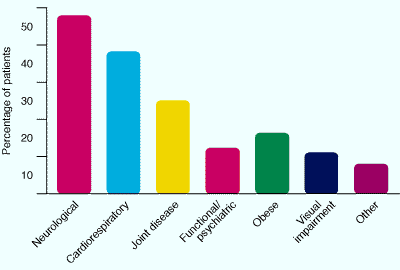
Causes of death in developing regions by year (Brocklehurst)
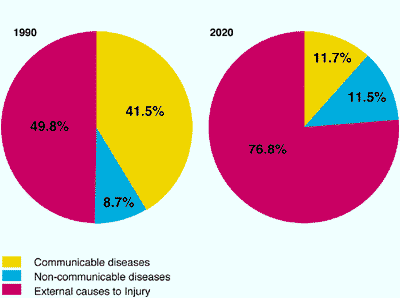
Number of chronically disabled Americans aged 65 and over, 1982-1986. This shows that not only are we living longer, we are healthier for longer.
(Butler, RN. Population aging and health. Brit Med J 1997; 315: 1082-1084)
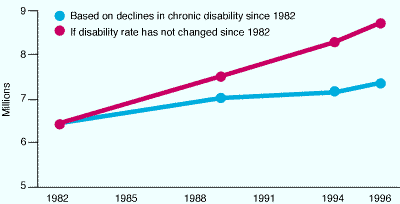
Older women are more likely to be disabled than older men. Although the "active life expectancy" of women is longer, the expected period of terminal disability and dependency is about twice that for men.
We are unlikely to achieve our full natural lifespans because,
with longer lifespans, there is:
- A longer lifetime of exposure to various potentially toxic agents (not all of which may be known)
- A problem of insufficient resources.
Therefore, healthcare workers will need to cope with increased pressure on health and social care resources.
The existence of more old people and more survivors of serious diseases has meant an increase in the incidence of morbidity and non-life-threatening but disabling chronic diseases and conditions